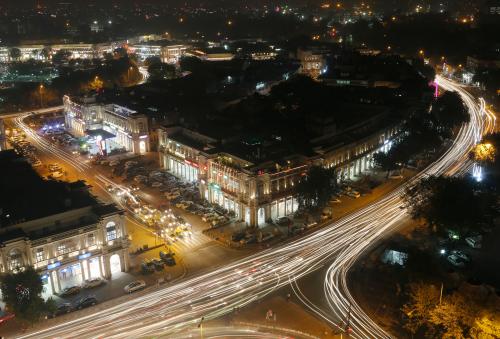Content from the Brookings Institution India Center is now archived. After seven years of an impactful partnership, as of September 11, 2020, Brookings India is now the Centre for Social and Economic Progress, an independent public policy institution based in India.
This article is a part of India 2024: Policy Priorities for the New Government, a compendium of policy briefs from scholars at Brookings India, edited by Dhruva Jaishankar and Zehra Kazmi, which identifies & addresses some of the most pressing challenges that India is likely to face in the next five years.
It is now widely recognised that India’s future will be urban. According to estimates by the United Nations’ World Urbanisation Prospects, India will see the highest increase in urban population in absolute numbers of any country. By 2050, it will add more people to its cities than are currently residing in them. This presents considerable challenges in terms of effective service delivery and livable conditions for urban residents. It must be noted here that as land and local self-government are the responsibilities of individual states, many crucial reforms are outside the mandate of India’s central government. With that caveat, the central government could still undertake a number of important policy measures.
Empower Metropolitan Bodies
Metropolitan regions are major growth drivers of the economy and hence worthy of policy attention and nurturing. However, metropolitan governance in India currently suffers from serious problems, including a lack of coordination among different organisations for provision of services such as solid waste management, transit, and mitigating pollution. Regional growth and its concomitant problems may also traverse state boundaries creating additional challenges of coordination among different state agencies.
Article 243ZE of the 74th Constitutional Amendment Act specifies that every metropolitan area in India should have a Metropolitan Planning Committee (MPC). The idea behind proposing an MPC was to create a coordinating body comprising ministers from state governments, locally elected councillors, and other professionals on metropolitan issues and for preparing regional plans. MPCs, where they have been constituted, have not been successful in discharging this role largely due to lack of finances and functionaries. Instead, metropolitan development authorities, which are state-controlled, are playing a significant role. The existing set-up needs to be restructured with a more empowered metropolitan body replacing both the MPC and development authority. This two-tier (city and metropolitan level) set-up should have a clear delineation of functions at the local and regional level along with revenue allocations. There is precedent for this kind of restructuring; metropolitan regions like London and Toronto have experimented extensively in order to improve outcomes at the metropolitan level. Restructuring metropolitan governance will require amending the 74th Constitutional Amendment Act.
Implement a Rental Housing Voucher Scheme
The situation of affordable housing supply in cities continues to be dire despite policy efforts by central and state governments. Direct provision of public housing has not succeeded in meeting its targets. To make matters worse, governments often implement land use regulations and controls such as restricting Floor Space Index or building heights that choke supply and drive up house prices. Given the vast number of households that do not have access to formal housing, the issue cannot be successfully resolved with a policy focus on creating a stock of ownership housing alone and requires rental housing to thrive. In urban India, the share of rental housing to total housing fell from 54% in the year 1961 to 28% in 2011.
Boosting rental housing must become the primary component of a comprehensive affordable housing policy. This involves addressing both supply side and demand side issues with regard to rental housing. Due to the fear of stringent rent control laws and extremely low rental yields, homeowners often prefer to keep houses vacant rather than renting them. Supply side reform will require state governments to amend rent control laws along the lines of the Centre’s Draft Model Tenancy Act 2015. The Centre can use the levers of grant finance and add a clause that states need to do this in order to get access to funds under different centrally sponsored schemes. On the demand side, the focus should be on creating and implementing a targeted rental housing voucher scheme. Under this scheme, households below certain income thresholds would be identified as beneficiaries and provided rental vouchers that cover the difference between the monthly rent and 30% of their monthly income. A potential challenge is lack of information on incomes making targeting difficult, but the issue is resolvable.
Transfer Revenue to Urban Local Bodies
Urban local bodies have to undertake a wide range of functions mandated by the 74th Constitutional Amendment Act. However, many do not have requisite revenue sources for fulfilling their responsibilities. There is a clear mismatch between the functions they have to undertake and their revenue streams. In the absence of reliable and autonomous revenue sources, a crucial way to provide predictable fund flows is through fiscal transfers directly to the third tier of government. Economist and former chief of Finance Commission, Vijay Kelkar, has proposed that both the state and the centre can share part of the GST revenues with urban local bodies — this will require a constitutional amendment. These revenues will be in the form of untied grants with local bodies free to utilise them in any form. Such an arrangement is also justifiable on the grounds that it gives taxpayers a stronger say in how revenues generated from GST may be utilised.
While these reforms may not seem to be very radical, they will be instrumental in improving the lives of millions. The new government needs to be willing to undertake these for the sake of ensuring a smooth urban transition.




Commentary
India 2024: An urban India
May 17, 2019